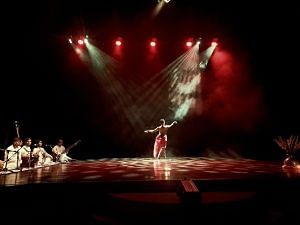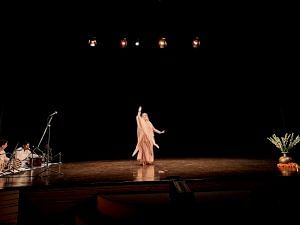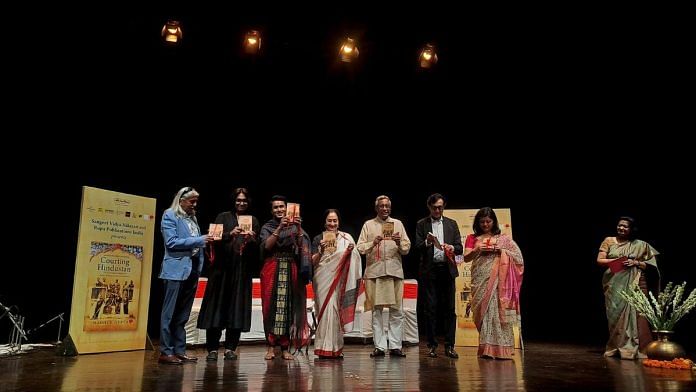New Delhi: For many, the idea of a courtesan is associated with dances, dresses, patronage, and plenitude. A contradiction in herself, a courtesan walked the tightrope between enjoying privilege and remaining an outcast in society. But courtesans were much more than objects of desire for the elite — one donated all her wealth to a Buddhist sangha, another commanded an army of her own and led a rebellion against the British Empire, and one more composed music for several Bollywood films. It was a courtesan who became one of the first artistes to record music in India.
All the myths, misconceptions, and mistakes of historiography became the hot topics of discussion at the launch of Madhur Gupta’s latest book Courting Hindustan: The Consuming Passions of Iconic Women Performers of India. While the book celebrates the lives of famous courtesans of India, the launch itself turned into a festival with the fusion of literature and performing arts.
The entire hall at Delhi’s Shri Ram Centre for Performing Arts glowed in the warm, amber embrace of diyas, the air intoxicated with exotic incense and mogra, sweet-sounding live music streaming in — it was almost as if a courtesan’s boudoir was brought to the heart of Delhi.

The launch event was marked with mesmerising performances and music. The enraptured audience and the spell-binding performances became a testimony to the words of Sanjoy Roy, managing director of Teamwork Arts and an invitee at the event: “Whoever says the arts are dead is rubbish.”
Beyond the bedroom
Popular history has often glossed over the complex lived realities of courtesans. History writers have portrayed them as decorative addendums to royal households existing between the court and the bedroom.
That’s the failing of contemporary discourses too. At Gupta’s book launch, the panel – comprising Sunit Tandon, Director, India Habitat Centre, Ambassador Pavan Varma, former civil servant, Guru Sharon Lowen, Odissi, Chhau and Manipuri exponent, along with Roy – touched upon how scholars still haven’t dissociated courtesans from their highly sexualised portrayal.

Courting Hindustan writes about several famous courtesans who we know little about. Few know that Begum Hazrat Mahal, a key figure in the 1857 rebellion, was at once a courtesan, queen, and commander. Gauhar Jaan came to be known as “the first recording superstar of India” in the 1910s, as she was one of the first to record music on 78 rpm records. Jaddanbai, the mother of Hindi actress Nargis, was one of the first modern filmmakers in India. Balasaraswati, whom Gupta calls “the last standing courtesan”, was even awarded the Padma Vibushan in 1977 for her rendering of Bharatanatyam.
Moreover, dance, for these women, was a private conversation between the individual and the divine. This way, courtesans created a space that was “public yet private”, Lowen noted. “Dance then becomes a puja (prayer).”
But popular perception still hasn’t brought this history out of footnotes.
Also read:
The British influence
Gupta attributes the lacuna in knowledge to colonisation. His book mentions that from time immemorial, Indian culture has sung praises of the “public woman”, the professional entertainer. Even ancient texts such as the Puranas and Buddhist literature revere the courtesan. The mud-slinging began with the British, who called the tradition “social debauchery” and courtesans “carnal criminals”. “The polyamorous nature of their lives was difficult to comprehend for the Britishers,” writes Gupta in the book.
It is far removed from what one would find on the inscriptions at the temples of Khajuraho and Konark, the panel surmised, which portray devadasis engaging with their sexuality. The artistry carved on stone with deep sexual connotations blurs the moral distinction between dharma (duty) and kama (desire).
“Performing is their bread and butter,” said Roy. For courtesans, their work was a mix of “passion and professionalism, where they created an environment that drove men into their spaces”. Gupta pointed out that young nawabs were even put under their custody so they could take lessons in tameez (manners) and tehzeeb (etiquettes).
Also read:
Performing arts aren’t dead
To fill the amnesia, the launch event sought to bring history out of pages. Since no account can truly capture the essence of dance and music, they’re “recreated through popular imagination,” said Tandon. The book is a good start at busting some of those myths, he added.
Gupta, a trained Odissi dancer himself, performed on Usha Suktam, a hymn dedicated to Usha, the goddess of dawn, and which is traditionally performed by devadasis. And like Usha, Courting Hindustan was a dawning for Gupta. “A stroke of fate, really,” he said.
And the discussion broadened into a larger dialogue about the state of performing arts in India.
“This richness of culture is the true wealth of India,” said Shivani Varma, a trained Kathak dancer who performed a tribute to late Pandit Birju Maharaj at the launch. Roy proudly stated that India is the “only country where young people want to learn classical arts, of their own volition.” The session concluded with his words that the arts are “very much alive and kicking.”
Performing arts in India aren’t dead — they just need to be supported, he added. And how does one do that? “You start by coming to the shows, bringing your friends and family and most importantly, buying the damn tickets.”
(Edited by Humra Laeeq)



